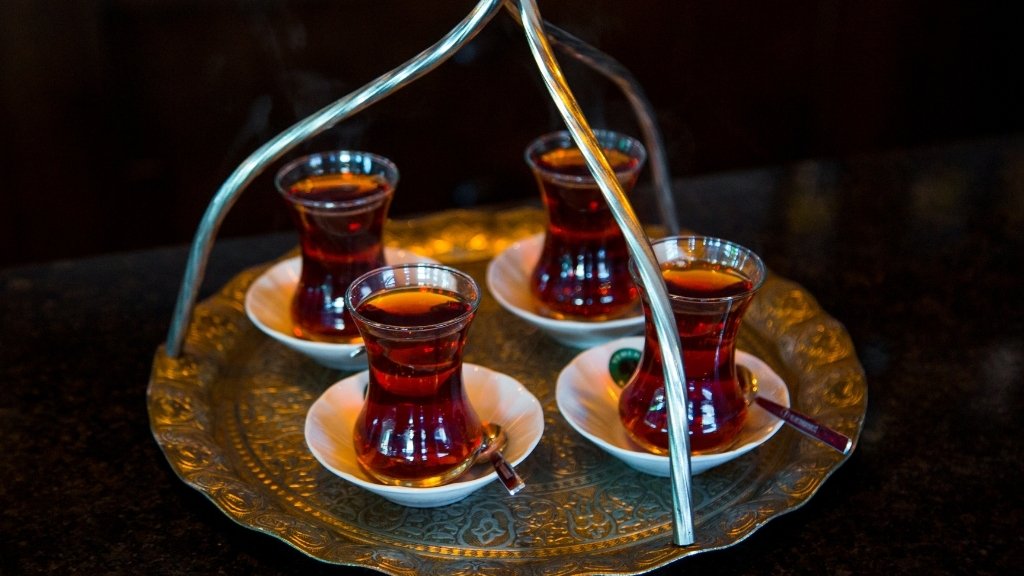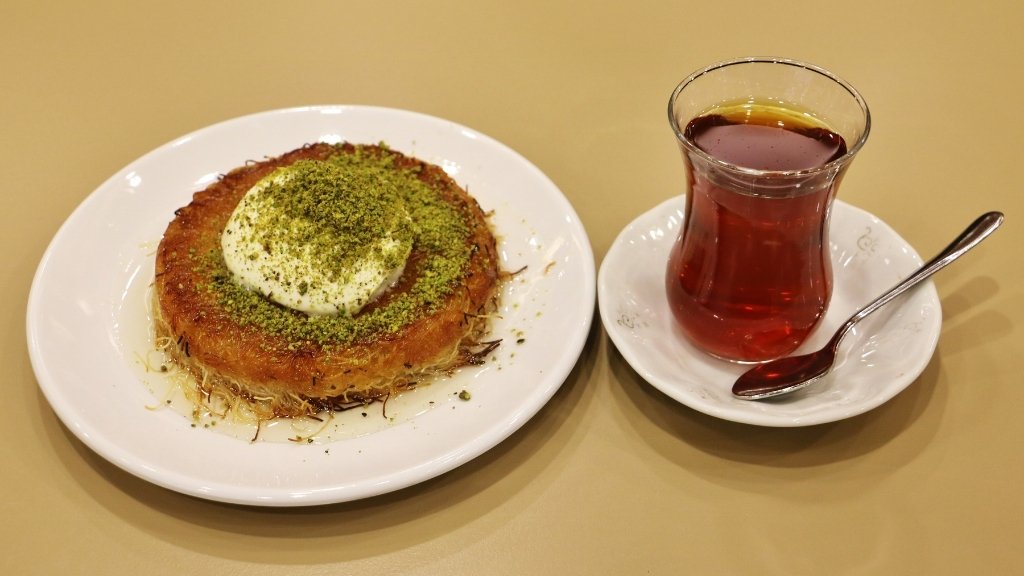Have you ever seen how, in Turkey, even a small tulip-shaped glass of tea seems to be everywhere? Whether it is in warm houses or noisy markets, Turkish tea culture is present everywhere. It’s not just a warm drink – it’s a heartfelt gesture of hospitality, a way to say “you’re welcome” without words. It unites individuals, whether it be catching up with friends, comforting strangers, or closing a business transaction.
In this article, we will conduct a closer examination of the reasons why Turkish tea culture holds such significance. You will learn about beautiful rituals, rich symbolism, and deep roots that keep this tradition alive in modern Turkey. It doesn’t matter whether you’re going on vacation or just interested in this story; it will warm you, just like the tea itself.
A Sip of Kindness in Izmir
I will never forget the day I was invited to Izmir, not by words, but by the Turkish tea. It was a dull, rainy afternoon, and I had just come along when a woman at the bus stop next to me quietly opened her thermos. She half-filled two hot glasses of dark red tea and poured them into tulip glasses, giving me one with a smile. We did not speak the same language, but in that little, warm moment, I experienced pure hospitality, silent kindness, and great human understanding all through one cup of tea.
The Heart of Turkish Hospitality – Why Turkish People Drink Tea Daily
A Daily Ritual That Frames the Turkish Day
Tea in Turkey is not only a beverage; it is a part of everyday life. The day is characterized by several tea breaks, from morning to evening. You can enjoy Turkish tea at home, at work, or while walking along a local bazaar; there is always time. This is unlike most places where tea is only used for relaxation or special occasions, but in Turkey, it is a rhythm that recurs every day.
Tea as a Symbol of Hospitality and Trust
Tea is not just a habit; it is a strong gesture of hospitality. When a person invites you to have tea in Turkey, it’s not just a courtesy but an invitation to their world. You are a friend, a guest, even a stranger, but saying no to tea might be similar to saying no to the connection itself. Drinking tea is the key to communication, trust, and respect.
Local Roots and Cultural Evolution of Tea
There is also a practical reason why tea is so deeply rooted. It is cheap, easily accessible, and cultivated locally, at least in the green part of Rize, which is the epicenter of tea production in Turkey. In the past, following the decline of Ottoman-era coffeehouses, tea became an integral part of daily life, aligning with the modern and secular image of Turkey yet preserving a sense of tradition.

Four steaming glasses of traditional Turkish tea are served in tulip-shaped glasses on an ornate tray, symbolizing the warmth and hospitality of Turkish tea culture.
Turkish Tea Culture Through History
From Late Arrival to National Treasure
Although tea is an inseparable part of Turkish life nowadays, this was not always the case. The Turkish tea culture did not start thriving until the 20th century. Before that, coffee ruled social life, particularly in the Ottoman period. However, with changes in the economy and political reforms, tea became a more feasible and convenient beverage and later a proud national icon.
The Rise of Rize: Heart of Tea Cultivation
The powerhouse of the Turkish tea industry turned out to be the Black Sea region, in particular, Rize. It has a humid climate, rich soil, and government encouragement, which all make it an ideal tea-growing region. Nowadays, Rize is not only a destination but also a source of local pride and the origin of most of the tea drunk in the country.
Ottoman Past vs. Modern Tea Traditions
Sherbet and coffee were popular beverages during the Ottoman era in ceremonial or elite contexts. However, in Turkey today, tea has found its habitat in its simplicity and its connection to daily life. It was in line with the new identity of the country – something humble, collective, and strongly rooted in the community.
Symbolism Behind Turkish Tea – More Than Just a Beverage
Red Like Rubies: The Symbolic Color of Turkish Tea
The red color of Turkish tea is not only aesthetically pleasing but also culturally significant. It is a deep color, representing life, warmth, and hospitality, and is sometimes compared to rubies or the pomegranate seed. It showcases the power of the tea itself and the impact it has on any table.
The Tulip Glass: Tradition in Every Curve
The tulip-shaped glass is a miniature yet mighty symbol of Turkish tea culture. Its design allows you to observe the color while keeping the tea warm at the bottom and cool at the top. In addition to its functionality, it showcases the Turkish passion for design, beauty, and tradition all in one.
A Shared Moment of Meaning
Tea drinking in Turkey is not a speedy process – it’s a meaningful ceremony filled with tradition, symbolism, and emotion. It is the way people stop, connect, and demonstrate respect for one another.
“Tea is not just a beverage in Turkey – it’s a silent language of care and connection,” – Dr. Cemile Demir, professor of cultural studies at Ankara University.
Turkish Tea Traditions in Everyday Life
Tea in Daily Connections: Business, Family, and Friendship
In Turkish tea culture, offering tea is more than just politeness—it’s part of every meaningful interaction. Whether you’re closing a business deal, visiting a friend, or catching up with family, there’s usually a small glass of tea in hand. It eases conversations and brings people together, acting as a silent yet powerful gesture of welcome.
Çay Bahçesi: The Soul of Social Life
Across Turkey, çay bahçesi (tea gardens) are popular gathering spots. From seaside locations to shaded city parks, these open-air spaces are where locals unwind, chat, or play games over endless rounds of tea. They’re not just cafés – they’re cultural landmarks where community life naturally flows.
Tea Serving Rituals and Respect
Traditional Turkish Tea is brewed using a çaydanlık. This double teapot allows for strong or mild servings, depending on the amount of water added. Guests are always served first as a mark of respect, and it’s customary to offer frequent refills because in Turkey, one glass of tea is never enough.
Brewing the Perfect Turkish Tea: Tools, Techniques & Taste
The Secret Behind Turkish Tea’s Unique Flavor
The distinctive feature of Turkish tea is its strong, slightly bitter taste, which is also due to the type of tea leaves and the slow brewing process. Turkish tea is also drunk without milk or sugar, unlike in other cultures where tea is accompanied by milk or sugar.
Traditional Brewing Method with the Çaydanlık
To make it right, you’ll need a çaydanlık—a special double teapot, just like locals do when they make Turkish tea the traditional way. This is how it works:
- Boil the water: Fill the bottom kettle with water and bring it to a full boil.
- Prepare the tea: Place loose-leaf tea in the top kettle and pour some of the boiled water over it.
- Let it steep: Allow it to steep slowly for 15–20 minutes. This gradual steeping yields all the flavor.
- Mix to taste: Pour some of the strong tea into a tulip glass, then dilute it with hot water from the bottom pot to your preferred strength.
Common Brewing Mistakes to Avoid
Most tourists do not know how to prepare Turkish tea, and they end up altering the flavor by:
- Using tea bags: These lack the complexity of fresh leaves.
- Over-steeping: It turns the tea overly bitter.
- Adding milk: This breaks with tradition and masks the true flavor.
Global Fascination with Turkish Tea
A Surprising Ritual for First-Time Visitors
The extent to which Turkish tea is integrated into daily life is a surprise to many tourists. Whether in bustling markets or on quiet street stalls, tea is not only sold, but it is also a sign of hospitality. When locals share a cup of tea, it becomes a cultural memory because it connects two people in a cup.
Turkish Tea Is Going Global
Turkish tea does not remain local. As exports to Europe, the Middle East, and other parts of the world rise, this daring brew is rippling across the world. Beyond the classic black tea, flavored varieties like Turkish apple tea are gaining international attention for their fruity twist and wellness appeal. Turkish cafes are also becoming international and introducing the use of tulip glasses to the rest of the world.
Another modern twist is the iced version of Turkish tea, which is gaining popularity both in Turkish cafés and among global tea enthusiasts. Learn how to brew it at home here: How to Make Turkish Iced Tea.
How Turkish Tea Differs from Other Traditions
Each tea-drinking country has its own ritual, but Turkish tea is different; it is strong and simple.
This is how it stands in comparison:
- Turkey: Strong black tea, bold and tannic, served in tulip glasses with optional sugar.
- UK: Milder black tea, creamy with milk and sugar, typically served in mugs.
- Morocco: Sweet green tea with mint, poured from a height to create a frothy top.
Turkish Tea is not only about the taste; it is about the place it occupies in ordinary life. It is part of the pace of life, whether it’s a business meeting or a family conversation. It is a drink, a gesture, and a tradition all rolled into one.
Modern Insights: How Turkish Tea Shapes Everyday Life
My Experience: How Tea Anchors Turkish Daily Culture
Having lived in Istanbul and learned about Turkish cultural heritage on a deeper level over the past decade, I have witnessed the role of tea, which is not just a beverage that sets the pace of life. It can be morning peace or evening rest, but Turkish tea is always present, hot, strong, and very comforting. If you want to explore its roots and wellness perks, Turkish black tea has a rich history and a long list of benefits worth discovering. Even without a word being spoken, it brings individuals together.
👉 However, with such frequent consumption, many people wonder: Is Turkish tea actually safe to drink daily? Learn more about its health effects and potential drawbacks in our in-depth guide on Turkish tea safety and side effects.
The World Tea Report also lists Turkey as the country with the highest per capita tea consumption, with over 3.5 kg of tea consumed annually. That tells it all about the location of its position in the heart of this culture.

Turkish Black Tea served with traditional künefe dessert, topped with pistachios.
Simple Etiquette Rules to Enjoy Turkish Tea the Right Way
Whenever you are offered a glass of tea in Turkey, here are some of the things you are supposed to do to enjoy the tea respectfully – or you can check our full guide on how to drink Turkish tea to explore proper etiquette and cultural do’s and don’ts.
- Always say yes: Saying no to tea can be perceived as rude – it’s a gesture of disapproval and unwelcome.
- Don’t add milk: Real Turkish tea is served plain to preserve its bold flavor and dark ruby color.
- Stir it gently: A light stir is fine, but never slurp – it’s seen as impolite.
- Ask for “açık çay”: If you prefer a lighter taste, this version, which has more water, is common among locals.
Choosing the Right Type of Tea
This is what the two most popular methods of serving Turkish tea are like:
- Loose-leaf tea: Rich in flavor, traditional, and full-bodied – but it needs skill and patience to brew it right.
- Tea bags: Quicker and easier, especially for travelers, but the taste is usually flatter and less authentic.
FAQs About Turkish Tea Culture
Why is Turkish Tea so popular?
Turkish tea is deeply ingrained in everyday life, as it is affordable, local, and consistently available in social settings. It is not only a beverage but a ritual of everyday life that is shared between generations. A glass of tea is always at hand, whether you’re at home, in a cafe, or at the office, and it makes you feel relaxed and connected.
What does Turkish Tea symbolize?
It means hospitality, warmth, and friendship. It is customary in Turkey to offer tea to guests, which signifies kindness and a desire to establish a connection.
Is Turkish Tea different from other Teas?
Absolutely. Turkish tea is characterized by its strong taste, its distinctive two-level brewing system (with a çaydanlık), and its absence of milk. This gives it a bold and pure flavor that distinguishes it from other varieties.
Do Turks drink tea with sugar or milk?
With sugar — not with milk. Milk does not pair well with the traditional Turkish tea culture, as it alters the original flavor that locals are fond of.
Why is tea served in tulip-shaped glasses?
The tulip glass is a Turkish icon. Its shape allows it to cool slightly, making it drinkable while still retaining its dark color. Besides that, it is an acknowledgment of the Turkish heritage, and this is what makes each cup a little more special.
Final Thoughts
Turkish tea is not only a hot beverage but also a daily routine that embodies warmth, tradition, and unspoken communication across generations. Whether it is its deep ruby color or the famous tulip-shaped glass, all these details open up a story of connection. Whether you are having a moment of solitude at home or someone hands you a cup in a bus station in Izmir, every drop is an invitation not only to taste the flavor but to experience the hospitality that accompanies it. When a person invites you to drink Turkish tea next time, agree, and you will not only enjoy the tea but also experience the culture.

Hi, I’m the heart behind Turkish Aura. I lived in Turkey for 10 beautiful years, where I fell in love with its tea, traditions, and soulful way of life. This blog is my way of sharing real stories, cultural wisdom, and personal experiences to help you feel the true essence of Turkish culture – just like I did.Thank you for being here, and love you!



